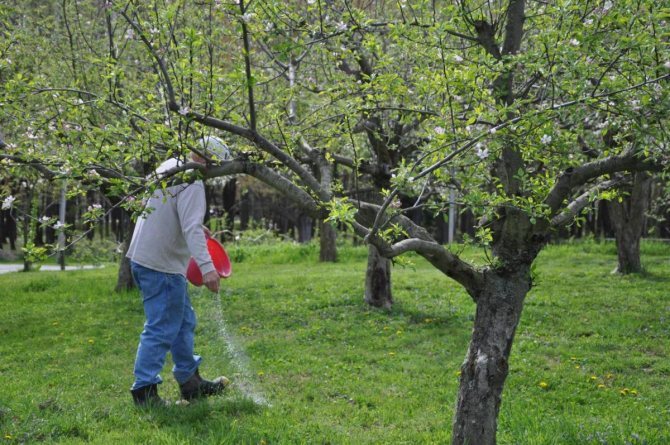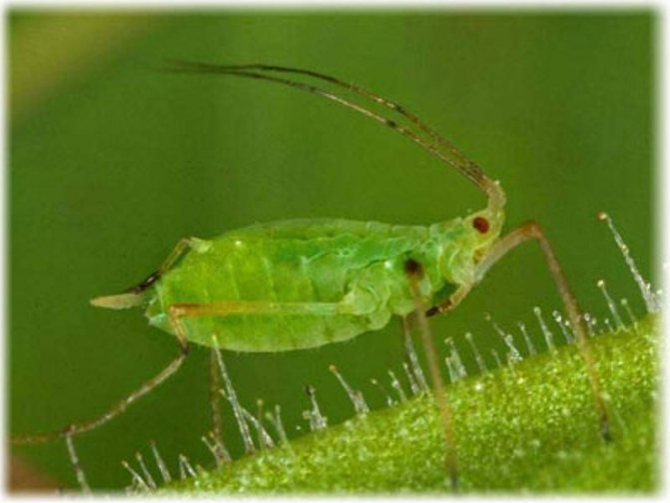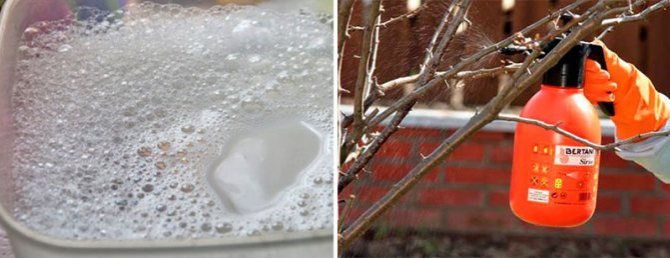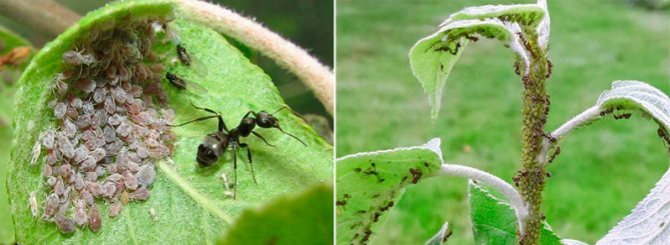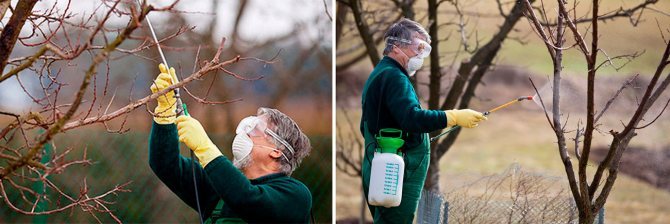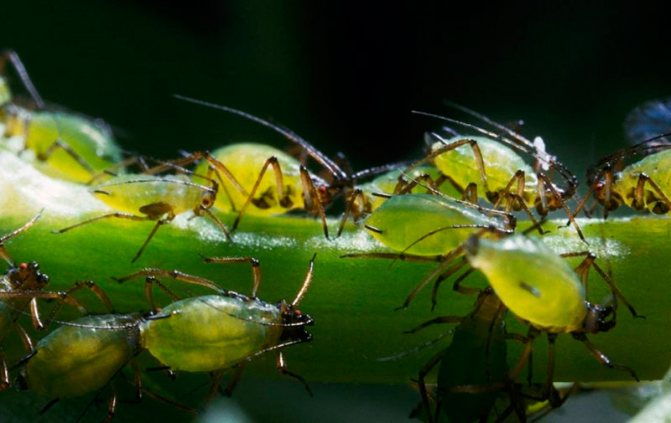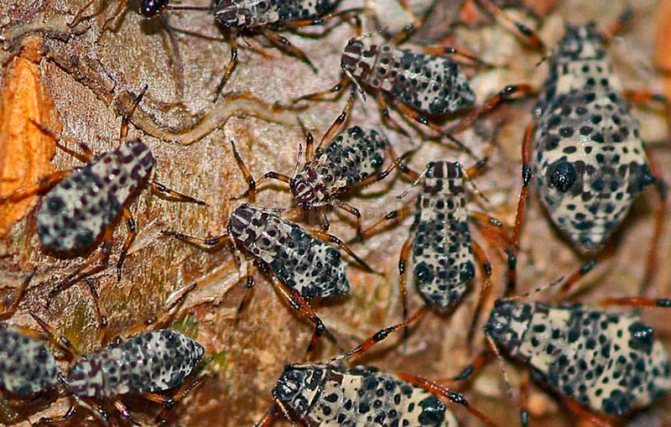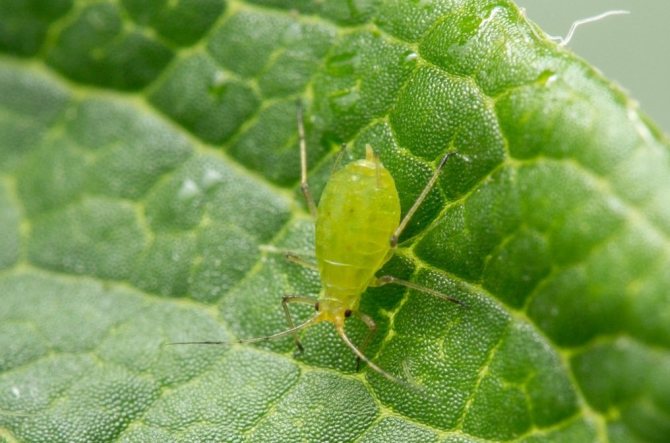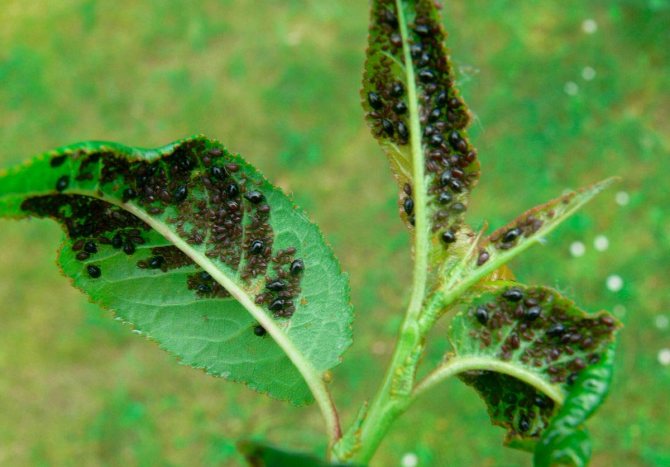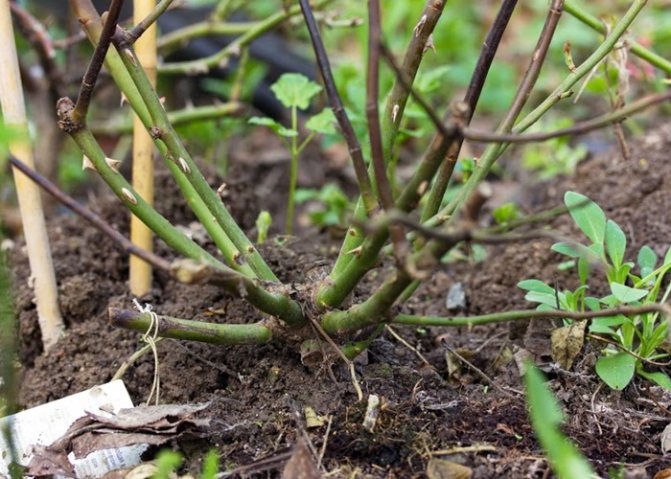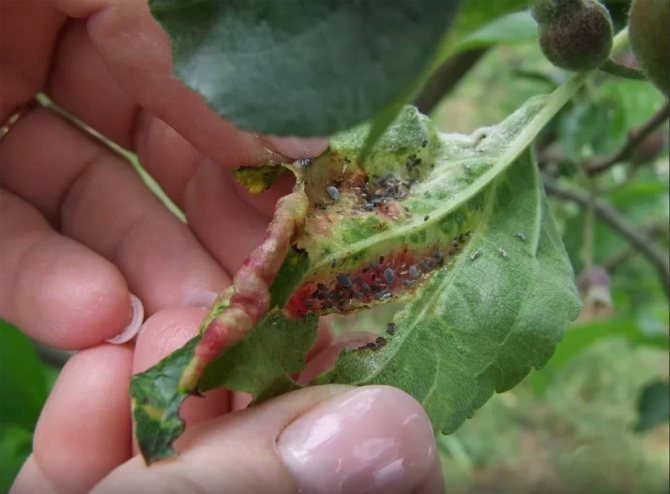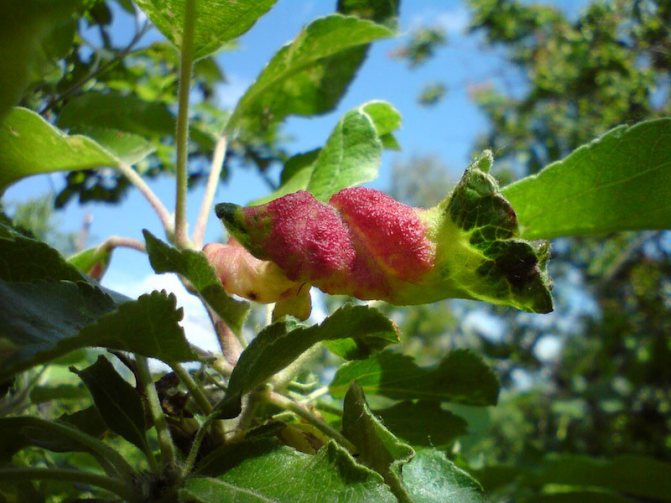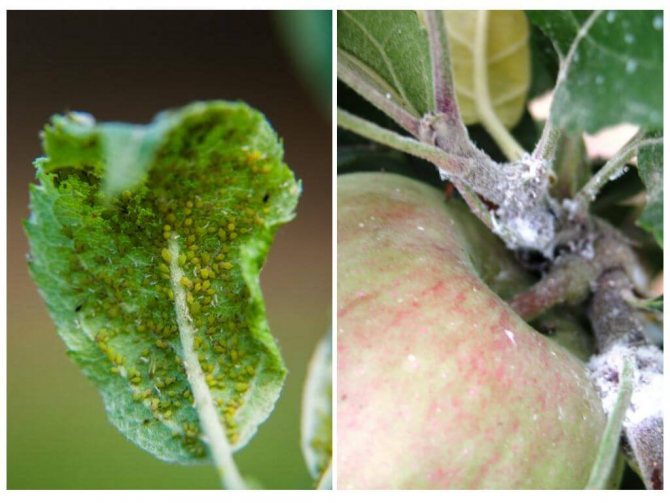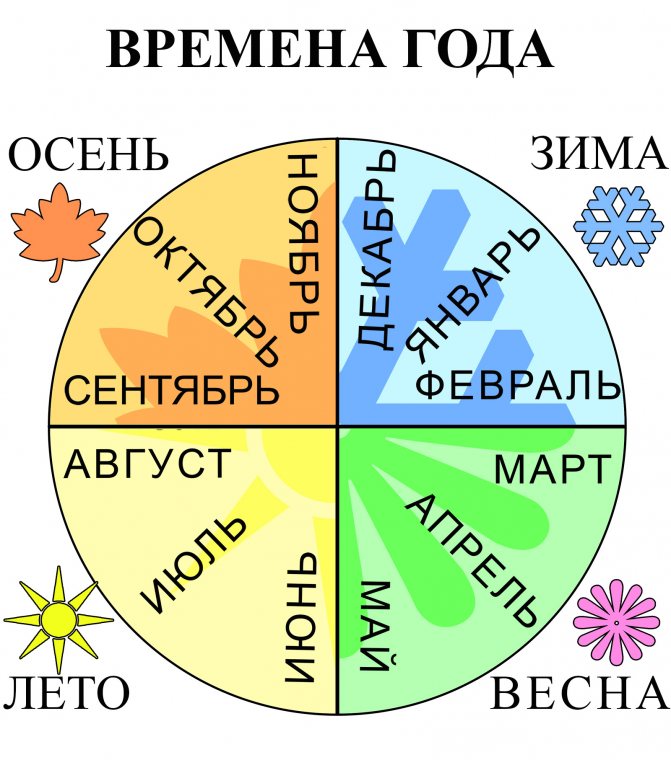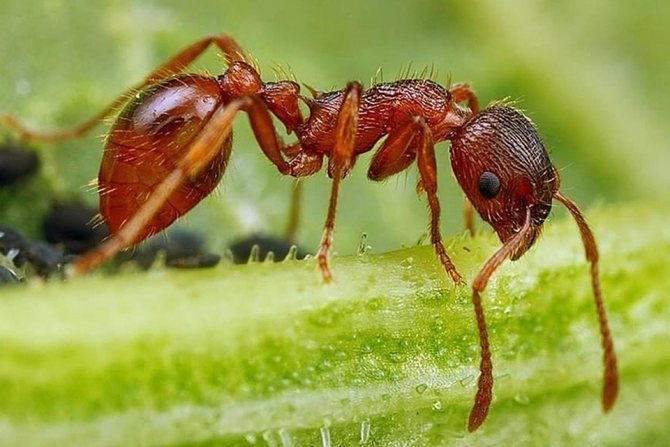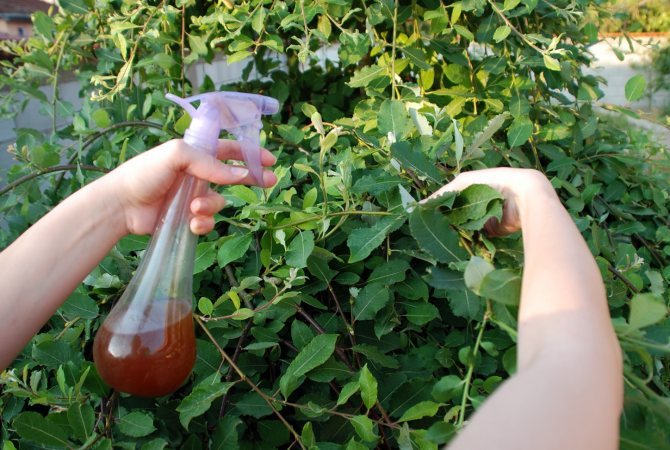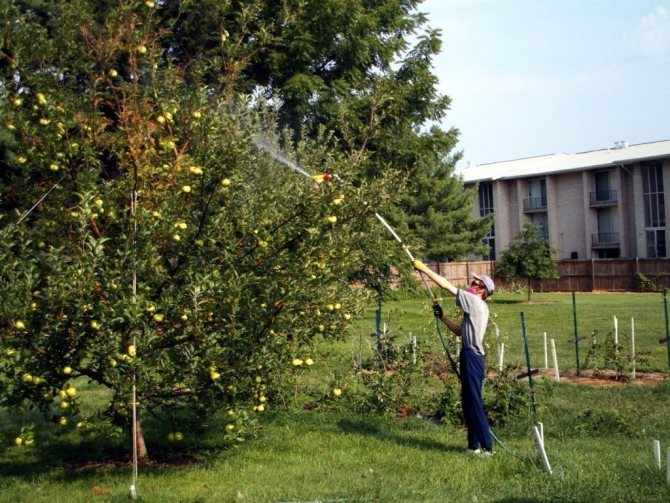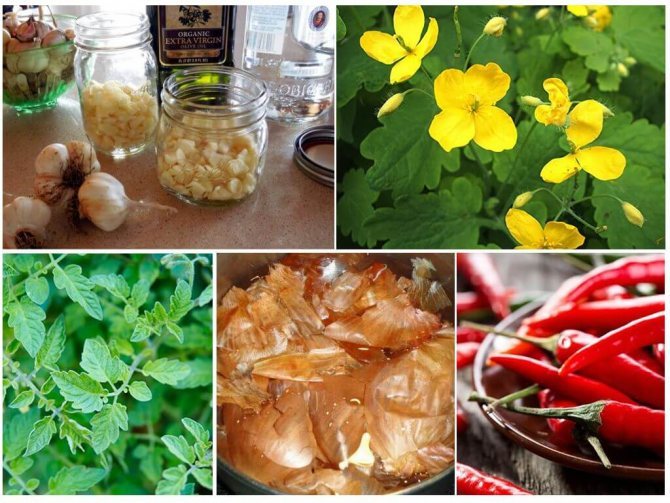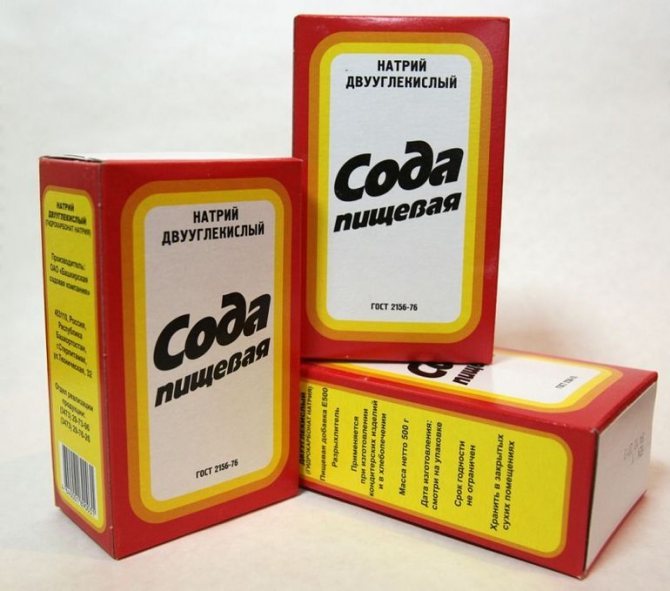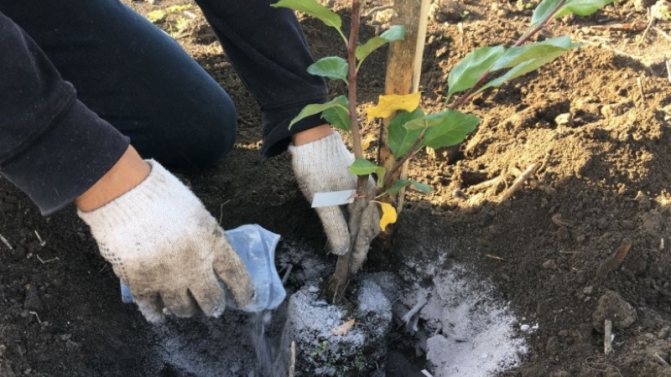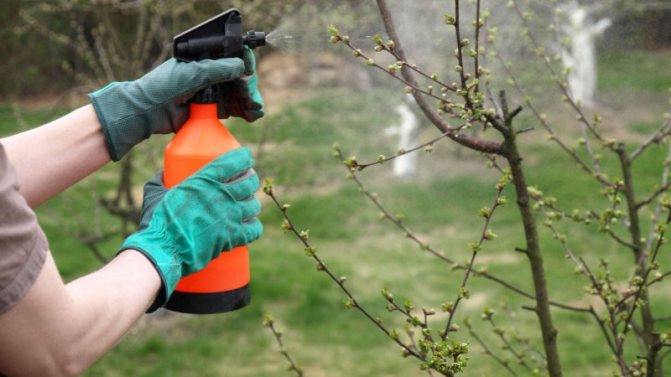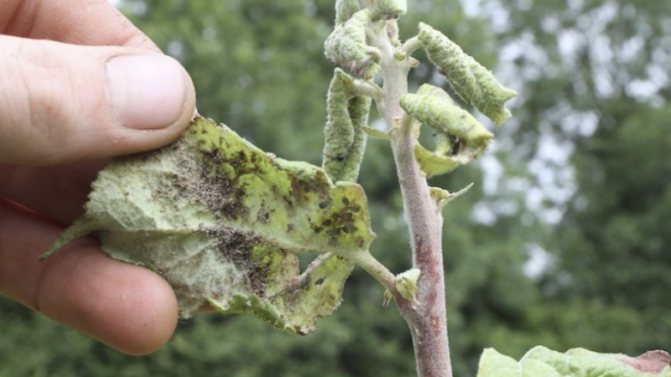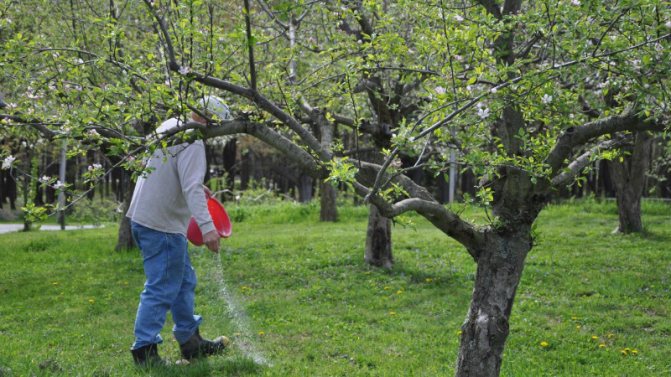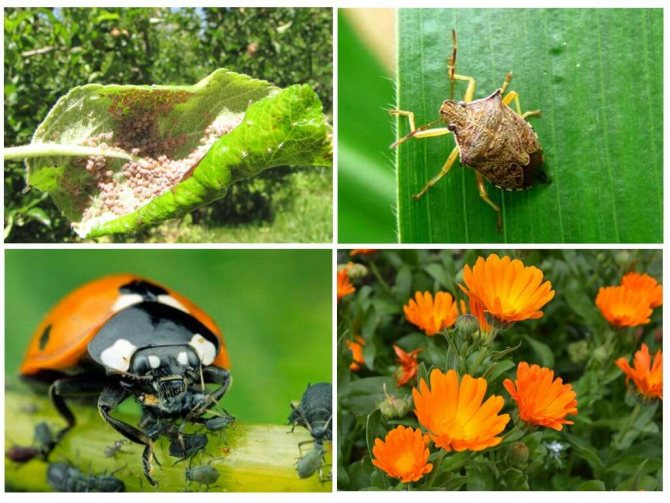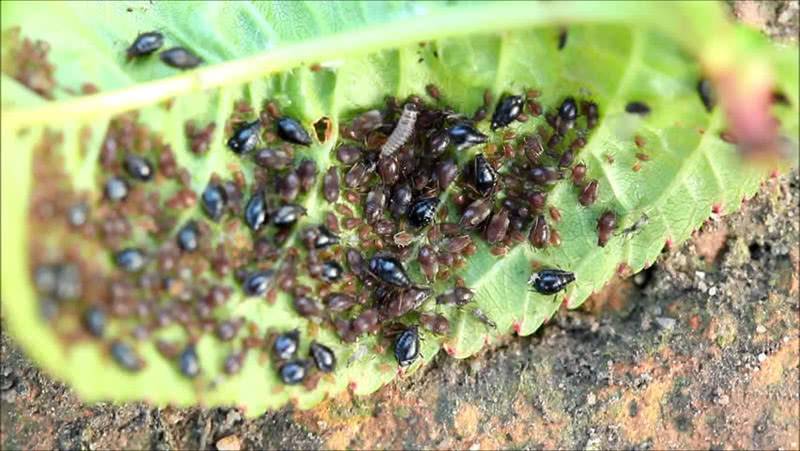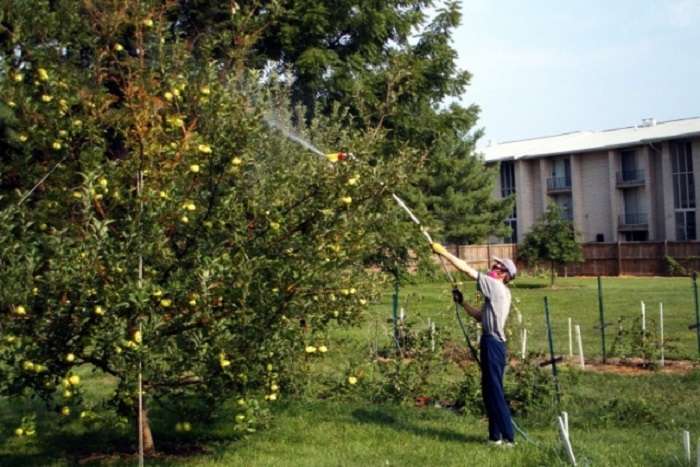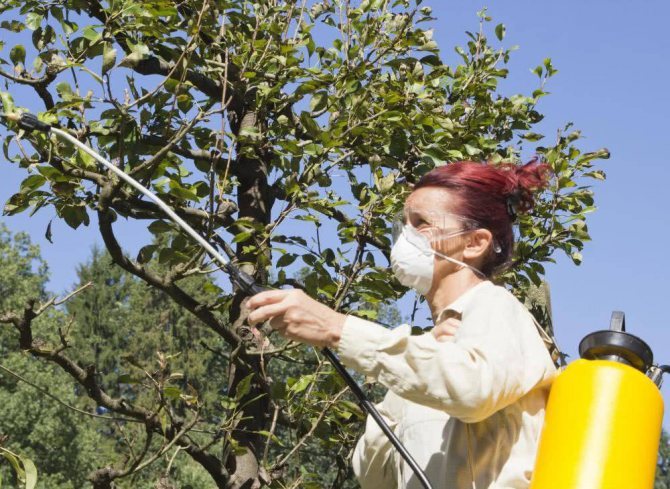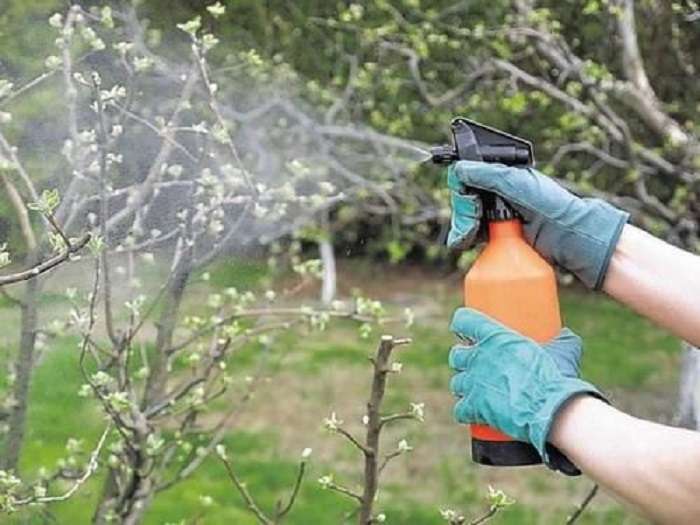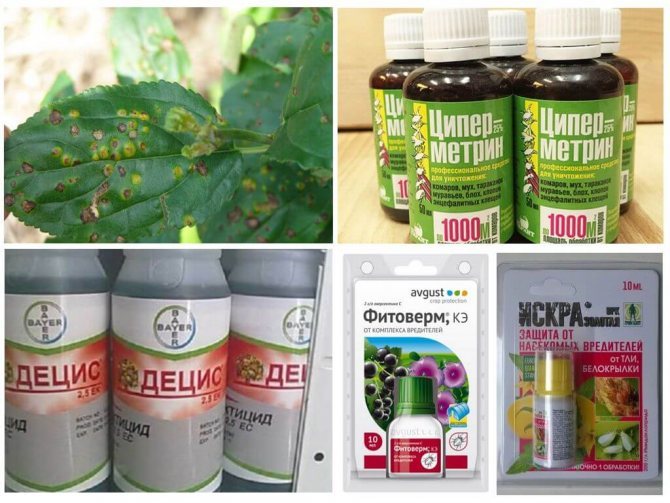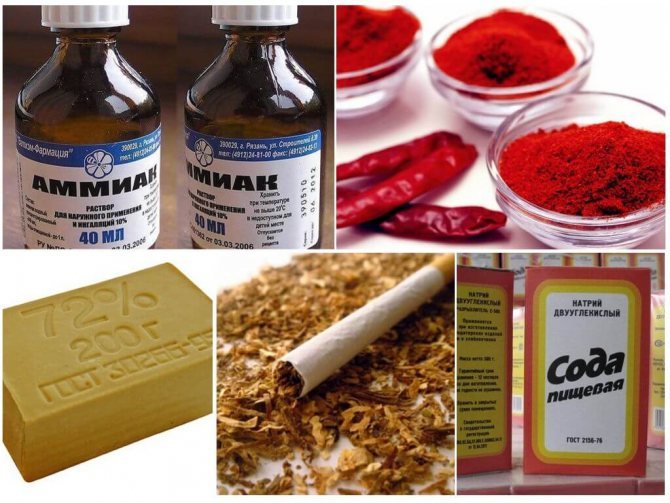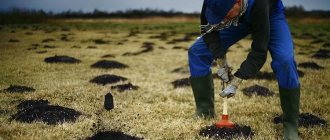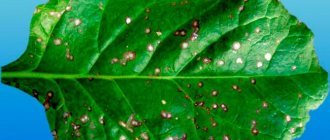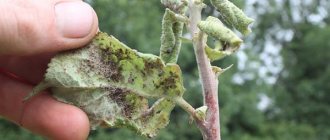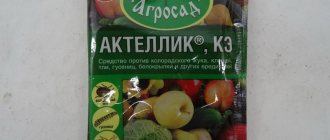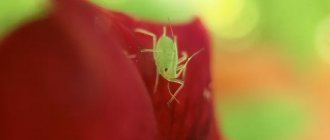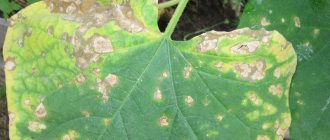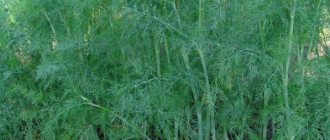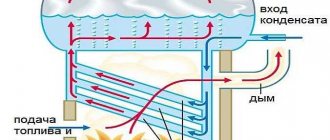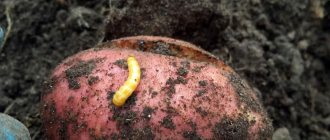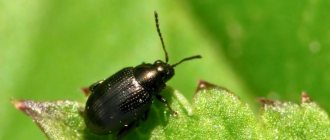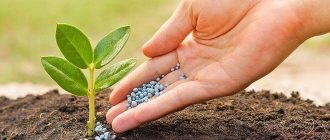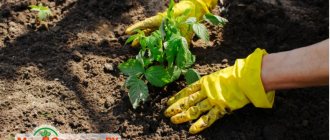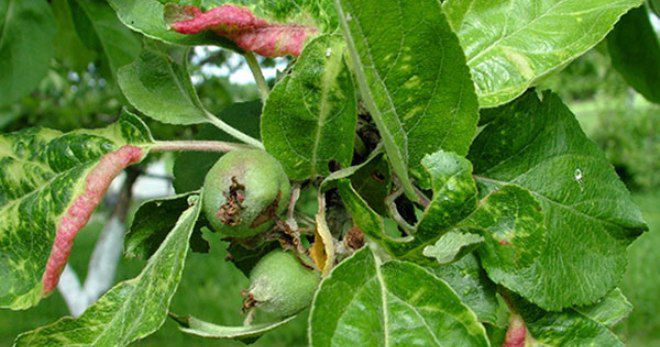
For many summer residents, a huge problem is aphids on an apple tree, how to deal with this scourge? After all, everyone wants to protect their crops. And even such a small insect can destroy many trees, in a short time these individuals storm the leaves with whole shelves. But do not despair, there are many ways to get rid of pests.
Aphid species
The life cycle of the apple aphid consists of several generations. Females lay eggs of light green color, which gradually change color to black. Wingless founders emerge from the eggs. Gradually, they develop into asexual virgins, which can be of two types - with and without wings. At the end of the growing season, normal egg-laying females and males appear. But females do not need the male's gametes to lay eggs, so insects reproduce at a tremendous rate.
Before you start fighting aphids, you need to study its varieties. And there are quite a few of them:
- Green apple aphid. They are small, greenish-yellow insects with a body length less than 2 mm. The pest is dangerous for apple trees, pears, quince, mountain ash, cotoneaster and some other plantings. It multiplies very quickly, so it can reduce the yield of the tree. Due to insects, red spots form on the fruits, the leaves curl, and the shoots bend.
- Red-gall aphid. Insects are brown-green, covered with white powdery hair, have black transverse stripes. Body length does not exceed 1.6 mm. Aphids affect leaf blades and fruits. In this case, all generations of insects harm the plant.
- Black aphid. It combines several types of insects at once, which have black, dark blue and green-brown color. It feeds on the juice of young leaves and fruits, for this it has a special proboscis. Because of this, the plant may die or its yield may decrease.
- Bloody. It got its name due to the fact that when crushed, a bright red spot remains in its place. Insects are ovoid, bright orange. Aphids populate on young shoots, leaf cuttings and stalks. At the site of their spread, deep ulcers form, through which harmful bacteria penetrate into the plant. If you do not remove the blood aphids, the plant will stop bearing fruit and die in 2-3 years.
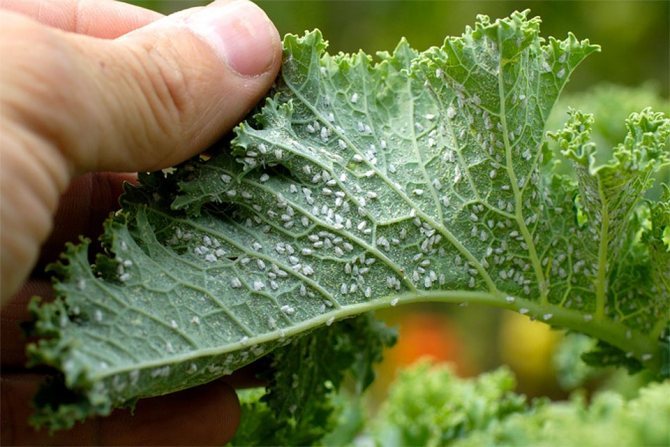

You need to carefully examine the trees in the garden in order to notice pests in time. Otherwise, yields will be significantly reduced.
Symptoms and Signs
In order to start fighting the pest in time, the condition of the fruit trees must be monitored constantly.
Signs of the appearance of aphids are:
- Tightening the leaves with a sticky bloom (pad), gluing the foliage.
- The appearance of red swollen spots on the sheet, resembling burns.
- Colonies of black, green, yellow dots on the underside of green leaves.
- Drying and curling of foliage.
- Deformation of young shoots, curvature of the tops of trees.
- Colonies of ants constantly scurrying near the apple tree and rushing to the tree.
Early infestation is difficult to spot on older trees in the garden. Aphids on an apple tree are initially colonized on young shoots, which are concentrated on top. Having sucked out all the juices from the young, the colony moves to the old branches and goes down.
The leaves of young apple seedlings should be examined regularly, remembering that the larvae live on the bottom of the plate.In old trees, the tops, where the main points of growth are located, are especially carefully examined. The increased attention of ants to the apple tree is a sign of aphids hiding in the leaves.
Aphids damage buds, eat flowers, spread viral diseases. After the invasion of the pest, there is no reason to hope for a good harvest of apples.
The main reasons for the appearance of a pest
Aphids are a very widespread, aggressive and incredibly numerous insect, and the apple tree, along with other fruit trees, as well as garden and ornamental plants, is the natural food of this insect.
Moreover, if some species of aphids, for example, the green apple aphid, are monophages, that is, they feed on only one type of food (in this case, the leaves and buds of the apple tree), then others, for example, the cherry aphid, may well parasitize on different crops.
Therefore, we can say that the main reason for the appearance of a pest in the garden is the very fact of the existence of this insect in nature. The gardener, of course, cannot influence this circumstance. And yet, parasites do not appear from anywhere, and, knowing the main "gate" of their penetration into the site, one can already try to take certain protective steps.
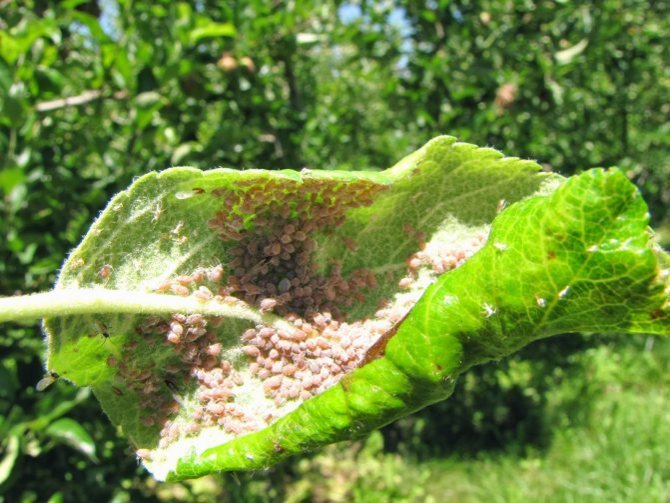

There are three main ways aphids get on an apple tree:
- populating the garden with migrating winged insect females;
- the emergence of a new generation of insects from eggs that overwintered in the bark or on the kidneys;
- "Transportation" of the pest by ants, the life cycle of which is very closely related to aphids.
Did you know? Ants take care of aphids as of a close relative: for the winter they can even transfer the adults and eggs of aphids to the anthill so that they do not die from frost, and in the spring they can plant them again on tree branches. During the "grazing" of aphids, ants also protect it from predatory insects, in particular, ladybirds.
A more active spread of aphids can be facilitated by favorable conditions, which, in particular, include:
- good weather - a combination of warmth and high humidity;
- improper nutrition of the apple tree, which causes an imbalance of minerals and other biologically active substances in the juice of its leaves (in particular, a lack of potassium and phosphorus, an excess of nitrogen and amino acids);
- the presence of problems with the bark of the apple tree, where ants and the pests transported by them are easily taken;
- the proximity of diseased trees and some types of weeds that can become a source of infection;
- an abundance of ants in the garden;
- lack of preventive treatments for apple trees with insecticidal preparations.
Video: aphids on an apple tree
Description and varieties
Aphids are a miniature insect that feeds on the leaves and fruits of various garden plants (you can read about what aphids eat here). Usually the body of aphids does not exceed more than 6-8 mm in length.... Its coloring can have a variety of shades (gray, black, whitish, light green, dark green, orange, etc.) and, in most cases, depends on the plant, the leaves of which they feed on.
Reference! By their biological origin, aphids belong to the phytophagous family.
A distinctive feature of this subspecies of insects is the presence of a small proboscis, with the help of which they destroy the upper covers of plants and absorb their pulp.
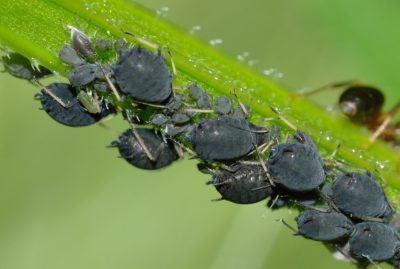

A species of aphid that infects apple trees is classified as: gray or red-headed... The eggs of this insect are present on almost any tree. In winter, they "hide" under the bark, and with the arrival of spring warming, female individuals hatch from them. After several weeks, and in the presence of a favorable environment, the females establish a colony, producing thousands of such insects.
Green apple aphids do not exceed 2 mm in length and have a different color: a greenish-gray body with a red head and white antennae. Over time, the color changes somewhat: the body turns noticeably black, and the abdomen turns green.The peak of aphid breeding, if no appropriate control is carried out with it, falls on the end of summer - early September.
Read more about the types of aphids in this article.
Signs of the presence of a parasite
It is not difficult to identify aphids on a young or adult tree, since it is accompanied by very pronounced symptoms:
- Reddish spots appear on the leaves of the apple tree, slightly rising above the leaf blade.
- The leaves curl, darken and gradually begin to dry out.
- A sticky liquid forms on their surface, attracting ants.
- On young shoots, cuttings and stalks, there are a large number of small insects that differ in color depending on the variety.
It is easier to determine the presence of insects on young seedlings, since they are of short stature, so any changes will be noticeable immediately. The fact is that aphids begin to parasitize on the upper shoots, so if the tree is tall, it will be problematic to immediately notice.
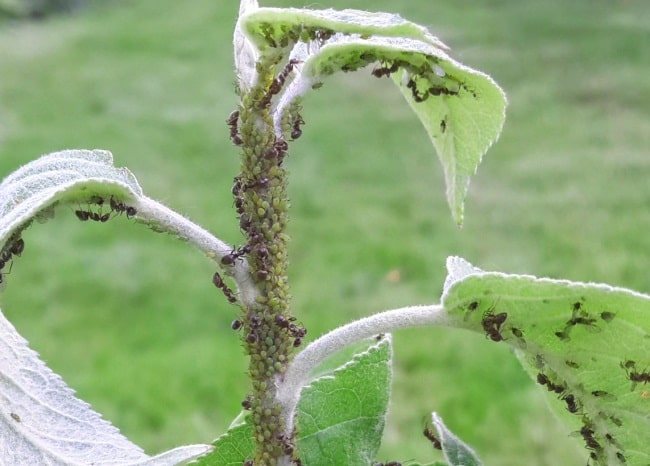

But gradually the insects become little food, so they descend to the lower tiers. To detect pests, you need to unfold the leaf, and on the back of it you can find many larvae.
Why is green apple aphid harmful?
Apple aphid damages stone fruit crops. She prefers young shoots. Aphids usually hide on the back of the leaves.
Insects feed on sap from young shoots, which is why they begin to curl and darken. Lack of nutritious juices leads to slower development of shoots or their wilting.
Aphids are most harmful to nurseries. With a strong infestation with parasites, trees that have not yet matured can die.
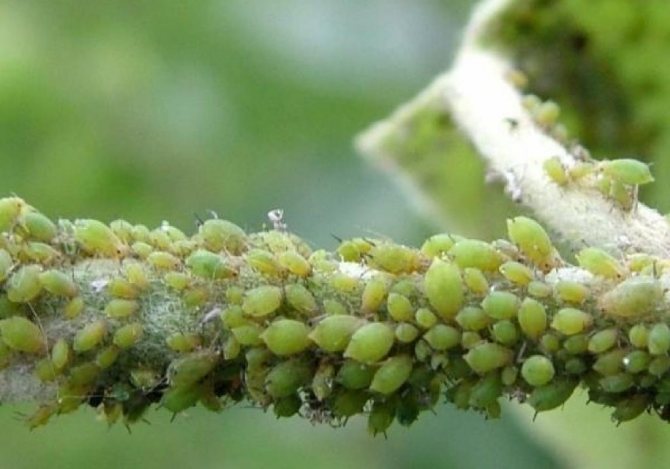

Apple aphid on a stem, photo
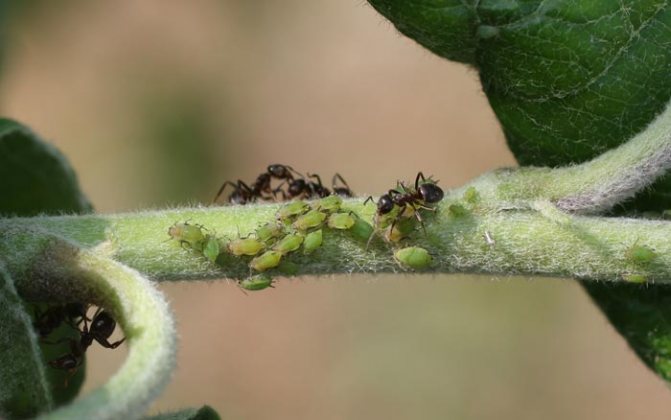

Apple aphid with ants
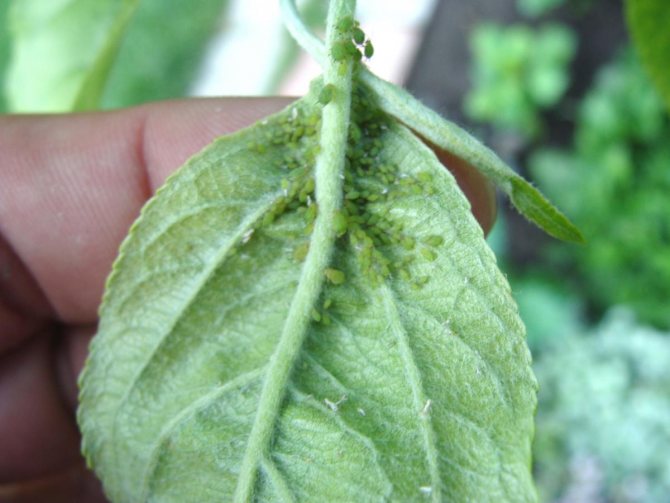

Apple aphid on a leaf, photo
When to start fighting
It is necessary to start destroying aphids as early as possible. It is advisable to do this immediately after its detection:
- During the flowering of the tree, the aphid will infect the opening buds. As a result, the flowers will begin to fall off. And this can lead to a lack of harvest. Therefore, it is recommended to destroy aphids before flowering.
- If it appeared in June-July, you need to spray the tree with special compounds immediately. Otherwise, insects will lead to the falling off of the forming fruits.
- If you spray the tree during the ripening period, the apples will have to be left on the tree for another 1-2 weeks. During this time, insects will die, and the means that were used for spraying will evaporate.
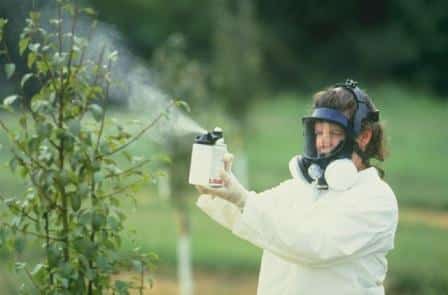

Therefore, it is advisable to regularly inspect trees for the presence of pests. The sooner aphids are identified, the less damage it will cause to apple trees.
What time of year should trees be treated
Garden owners must keep an eye on the trees at all times. As soon as pests are found on them, it is necessary to immediately take emergency measures to destroy them. But you should know that processing in the spring, when only the leaves begin to bloom, should be carried out with the help of folk remedies. But you can fight more actively in June when adults begin to appear from the eggs. After flowering, biological preparations, physical methods, chemical insecticides are used, you can use folk remedies.
Important!
Chemical preparations should not be used 3 weeks before harvest. Between spraying, you should take a break for at least a month, otherwise, together with the fruits of the apple tree, the poison contained in the preparations penetrates into the human body.
Apple processing in different seasons and flowering phases
Now you know how to treat an apple tree from aphids and ants, and you need to decide when to do it. It is best to apply pest control in early spring..
- In the spring: treatment chemicals produced before bud break. It is also necessary to process the bark, where the eggs of the pests hibernate.During the budding period and at the end of flowering - infusions and decoctions;
- In summer use mechanical, agrotechnical methods apply biological plant protection products (drugs and insects);
- In autumn: infusions and decoctions - 14-40 days before removing the apples from the tree. Physical methods: pruning diseased and old branches, burning foliage. Apple bark processing chemicals (egg wintering places) can be carried out after falling leaves.
Aphids are a dangerous pest. But today there are many methods of dealing with it. The main thing is not to miss the time of the appearance of the "unexpected guest" and start processing on time.
You can learn more about the fight against aphids in the video below:
Biological methods of what to plant under an apple tree from aphids
Aphids can appear in any garden. It affects not only apple trees, but also other fruit trees, tomatoes, roses. It is not necessary to use harmful chemicals to scare it away.
To protect a crop, you can plant the following plants next to it:
- Pyrethrum. It contains pyrethrin, which has a destructive effect on the nervous system of insects. Once it enters their body, it causes paralysis. Insects die because they cannot move and feed accordingly. Some individuals can survive, but they lose reproductive functions.
- Lavender. It is a perennial plant with a pleasant smell and bright purple flowers. Grown as an ornamental. Contains essential oils and strong aromatic components. This repels pests.
- Marigolds (calendula). It is an annual plant with orange or yellow flowers. The leaves, stem and flowers have a strong scent that repels aphids.
- Garlic. Its specific pungent smell is not to the liking of aphids, so it does not settle next to it.
- Marigold. These are annual or perennial plants. The flowers can be pure yellow or variegated - reddish yellow. However, it is recommended to choose thin-leaved marigold varieties. Otherwise, snails can start on them, which over time can go to apple trees.
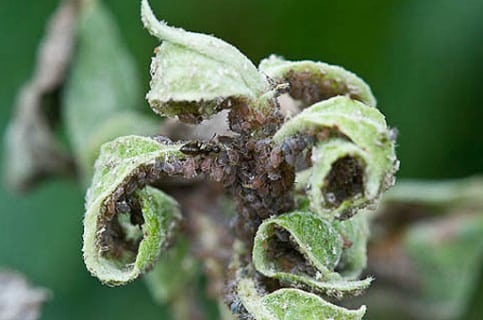

Such plants are very effective at repelling aphids. Moreover, they are completely safe for the human body, in contrast to aggressive chemicals.
Danger of aphids for apple trees
The actions of aphids cause very serious harm to apple trees in the garden:
- The appearance of a sticky liquid is noted on the leaves of the tree;
- Also, the leaves may have a curled appearance, and then dry out;
- The leaves have red spots at the top;
- The growth of new shoots stops;
- The harvest is significantly reduced.
Flower beetle on an apple tree: how to fight
The very peak of pest activity occurs under conditions of high humidity and high temperatures.
Additional Information. The curled leaves, which are a sign of aphids on the tree, are formed by the insect injecting a certain substance. Under its influence, leaves of a similar shape, similar to a house, acquire. In it, aphids are hiding from enemies.
Natural methods
This event solves the problem - how to get rid of aphids through living organisms, planting plants that can scare them away. This includes:
- Extermination of ants that feed on the sugary bloom of aphids and protect them
- Planting special vegetation that repels aphids and other pests of cultural plantings. These are calendula, garlic, tomato tops, dill, tansy, lavender, Dalmatian chamomile. Plants with a high content of phytoncides - marigolds, basil, coriander, etc. They are placed in groups in the garden area. It is also advisable to check that next to the fruit plantings there are no attracting parasitic pests - linden, viburnum, nasturtium, tuberous begonia, mallow, kosmeya, hypnotic poppy
- Arrangement of birdhouses near fruit trees with organization for birds (titmouse, robin-robin, linnet, sparrows, korolki, urticaria) good conditions (availability of drinkers)
- Assisting in the reproduction of pests that are destructive for the pest: wasps of certain species, lacewings, bedbugs, ladybugs, hoverflies, etc.
In order to lure useful birds into the apple orchard, allies in the fight against the rapidly multiplying parasite, they do not weed out nettles, grow spices and aromatic herbs.
It would be good if pests had to be dealt with not by us, but by their natural enemies. And such enemies exist in aphids, so the treatment of apple trees from aphids with chemicals is not always justified.
Insects that eat aphids include: hoverflies, ladybugs, lacewings, earwigs, parasites, ground beetles and other predatory inhabitants of the garden. To attract them, fragrant herbs are grown in the garden.
The ladybug is a natural enemy of aphids.
Aphids are eaten by small birds or feed for chicks. Sparrows, tits, bloodworms, wrens, linnet are not averse to using the pest for lunch. They also need to be attracted to your personal plot: make birdhouses, put drinkers.
Wren is another helper in the fight against aphids.
Attention! Treatment with pesticides is prohibited if you use biological methods to control aphids.
There are also plants that contain phytoncides, which scares away aphids. These are herbs with a strong aroma:
- Marigold;
- Coriander;
- Garlic;
- Mint;
- Basil;
- Lavender;
- Other.
They can be placed in small groups in the garden area.
And how to sprinkle apple trees from aphids without "chemistry"? Special preparations are also referred to biological methods of control. Biological "drugs" are more environmentally friendly. They contain extracts from plants and herbs.
Most gardeners prefer this series of drugs. For example, Aktarin and Aktofit help from aphids. They can be used both during flowering and in the budding phase and fruit setting, because they will not cause harm.
Biological methods for removing aphids
Such methods involve the use of enemies of parasites - birds, ladybirds, odorous plants. It is necessary to create conditions on the territory of the garden that are attractive for "helpers":
- Plant tansy, lemon balm, garlic, tomatoes near the apple trees.
- Place bird feeders on the trees.
- Do not kill insects that feed on aphids (lacewings, etc.).
- Remove anthills from the garden.
Sometimes it is enough to "drive" the ants away from the apple trees for the aphid to disappear.
Chemicals
The use of insecticides and pesticides is the most effective method of controlling aphids. Harmful insects die almost immediately or several hours after spraying pesticides.
There are a wide variety of chemicals that can be used against aphids.
But in order for the use of such drugs to be effective and safe for humans, a number of simple rules must be followed during the procedure:
- You need to spray the tree in good dry weather, there should be no wind. Chemicals work even after rain, but if they are not washed off with water, the effect will come sooner.
- It is advisable to wear a mask over the eyes and mouth, gloves. Work clothes must be taken, and after spraying, immediately remove and wash.
- Pour the product into a garden spray bottle. After the procedure, it must be washed well, and it is better to spray the rest of the product on the neighboring trees for prevention. Do not allow chemicals to enter waterways.
- Processing is best done in early spring before bud break. Thanks to this, overwintered aphids will quickly die.
- It is not necessary to spray from top to bottom, but from bottom to top. So the product will get to the back of the leaf, from which the pests are located.
- If the chemical gets on the fruits, it is not recommended to pluck them for at least 2-3 weeks.After that, they will need to be washed thoroughly.
- You can not spray pesticides during the flowering of the tree. They lead to the death of bees. As a result, pollination will not occur, and the apple tree will not produce a crop.
- The finished product should be used immediately or during the day. You should not leave it next time - its effect will decrease.
- It is recommended that you purchase a new insecticide every year. The fact is that aphids can develop immunity to the same agent. Therefore, she will not die.
See also
Description and characteristics, cultivation features and regions for apple varieties A gift for gardenersRead
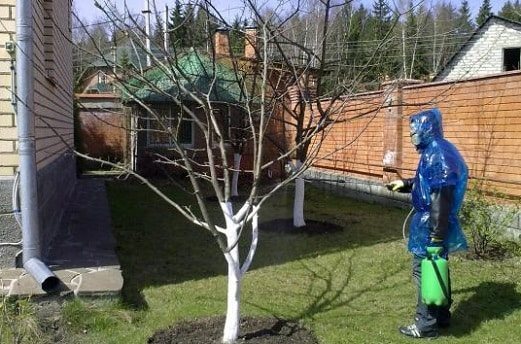

These simple rules will allow you to get rid of pests quickly and efficiently.
Nitrofen
If you spray the garden with it in early spring, it will save the trees from various pests - aphids, snails, caterpillars and others. In addition, spraying with Nitrofen is an excellent prevention of scab and other diseases. It comes in the form of a brown paste that dissolves well in water. To prepare an effective solution, it is necessary to dilute 200 g of the product in 10 liters of liquid. But it is forbidden to use the remedy for green vegetation, it can be applied either in early spring or late autumn.
Oleocobrite
Contains petroleum oil to help kill pests quickly. To achieve the effect, the concentration of the solution must be 4%. That is, 400 g of the product must be dissolved in 10 liters of water.
Kinmix
This is a drug of contact and intestinal action. Helps protect the apple tree from aphids, caterpillars, ants and other pests. After spraying, the product will kill them within a few hours. To prepare the solution, it is necessary to dilute one ampoule of the drug with 10 liters of water.
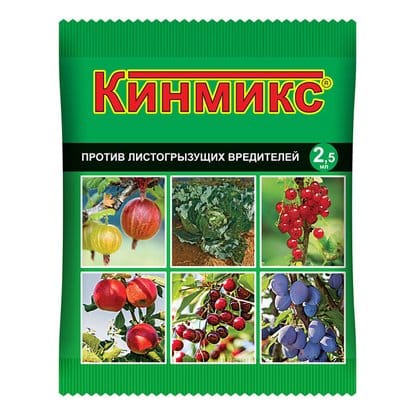

Spark
With the help of such a tool, you can fight various pests. It is suitable not only for horticultural crops, but also for indoor plants. Available in pill form. To prepare a spray solution, dissolve 1 tablet in 1 liter of water. Then strain and add another 4 liters of liquid. Process the apple tree. Re-spraying is recommended after 2-3 weeks. The drug has an intestinal contact effect.
Insects will die after eating the sprayed leaves.
Cypermethrin
Available in the form of tablets or water-soluble solution. Contains 8 isomers effective against Lepidoptera and Coleoptera. Quickly destroys aphid populations. Paralyzes both larvae and adult insects. It persists for a long time on the surface of leaves (up to 30 days), is characterized by resistance to high temperatures and sunlight.
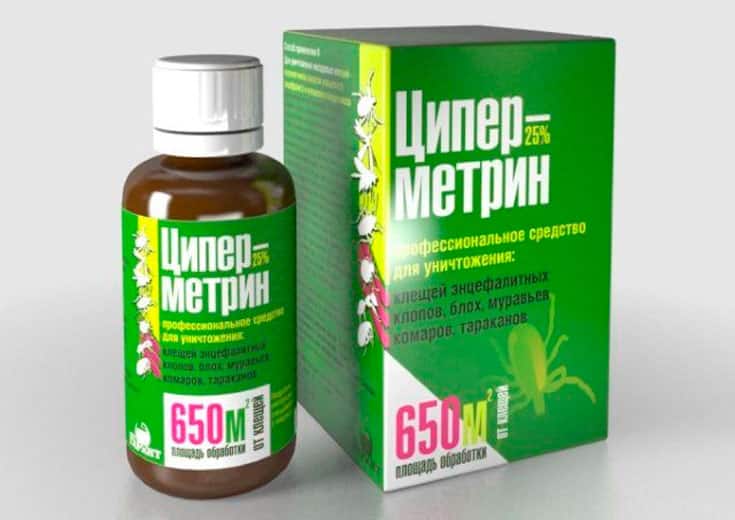

Karbofos
After spraying, the drug immediately begins to act and destroys aphids. In this case, the remedy has an advantage - its effect does not last long, up to 2 weeks, after which it begins to collapse.
Contains malathion, an organophosphorus compound. It is necessary to dilute 90 g of the drug in 10 liters of water. An emulsion is formed, which will need to be sprayed on fruit trees.
Decis
Decis is a universal remedy that destroys all types of harmful insects that live on garden and indoor plants. The product has a good contact-intestinal effect, destroys aphids in about 12 hours after spraying. Produced in sachets of 1 g. This amount must be diluted in 20 liters of water and used as directed. The use of Decis is an excellent prevention of aphids - the insecticide will protect the apple tree for 30 days after spraying.
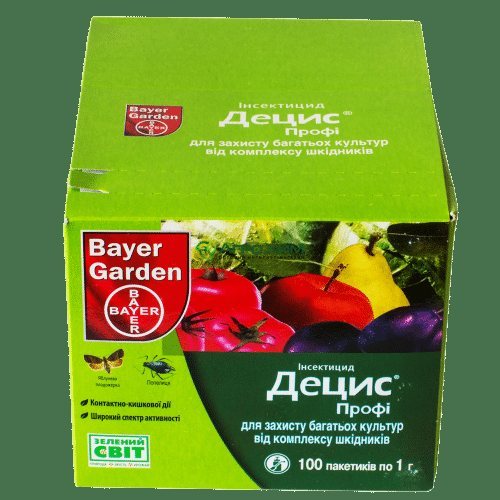

Intavir
Intavir is also a versatile product that is suitable for the destruction of more than 50 species of insects, including aphids. The active ingredient of the drug is cypermethrin. Once in the body of insects, it causes paralysis and death. Available in pill form. One tablet is designed for 10 liters of water. Only freshly prepared solutions are suitable for spraying.
It is not recommended to store them for longer than a day, as this will lose their effectiveness.
Karate
Karate preparation is a very effective remedy. Available in the form of a water-soluble liquid. For 10 liters of water, you need to take 250 g of the product. It is recommended to spray trees in the morning or in the evening in calm weather. The drug is toxic to fish, bees and birds. Therefore, it must be used with caution.
Use of chemicals
When all the possibilities have been exhausted and the knowledge of how to get rid of aphids on an apple tree with folk remedies has not helped, and aphids continue to eat young leaves of an apple tree, we turn to the "heavy weapon" - chemicals. They include preparations of contact, intestinal or joint action.
| Drug name | Act |
| Actellic | It has a contact and partially systemic effect. Sold in ampoules. Spraying is done with a freshly prepared solution, which is evenly applied to the leaves. Hazard class 2: may cause harm to people or animals |
| Aktara | Spray 2 times with a weekly difference. After 30 min. after exposure, the insects stop feeding, and after 24 hours they die. Hazard class 3, toxic to a number of insects. |
| Inta-vir | The impact is intestinal and contact. Available in tablets. Treat the apple tree three times if the aphid appears again. Apple trees are processed before flowering. |
| Spark | The action is intestinal and contact. Tablet form. Spraying is one-time, repeated (if insects are not destroyed) is carried out after 20 days. The degree of danger is moderate |
| Confidor | A systemic drug that enters the culture through all its organs is not washed off by rain. The effect is observed several hours after treatment. Protects the tree for 15-30 days. |
Attention! Spraying should be carried out in closed overalls, if the weather is without wind and rain. After processing, dispose of the remains of the product, wash hands and face, change clothes.
How to prevent contamination of neighboring trees?
Aphids quickly spread throughout the site; they should be disposed of at the first sign of infection. Severely damaged shoots are best removed immediately and burned together with insects.
What measures protect against the spread of aphids on the site:
- Mowing grass in near-stem circles, removing weeds throughout the area. Young shoots of the apple tree are dug up as soon as it grows, since aphids are especially fond of young foliage.
- Whitewashing and cleaning of tree trunks. Exfoliating bark is removed regularly to prevent egg laying. It is necessary to whitewash trees with lime in winter, it protects plants from many pests. The trunks are cleaned with a stiff brush, the wounds are smeared with iron vitriol and pitch. It is whitened by adding copper sulfate to the lime.
- Do not allow ants to excessively multiply in the area, monitor the population. Complete extermination is not recommended - ants help pollinate plants when other insects are lacking. Sprinkle circles around the apple trees with dry mustard, tobacco, destroy anthills near the tree.
- Prune trees on time, do not thicken the crowns, do not allow garden crops to join into a common array, maintain a sanitary distance. This will facilitate ventilation, air flow, and prevent aphids from infecting all plantings at once.
- Do not exceed the application rate of nitrogen fertilizers. Excess nitrogen weakens the defenses of apple trees. Nitrogen fertilizing is carried out no later than the beginning of summer.
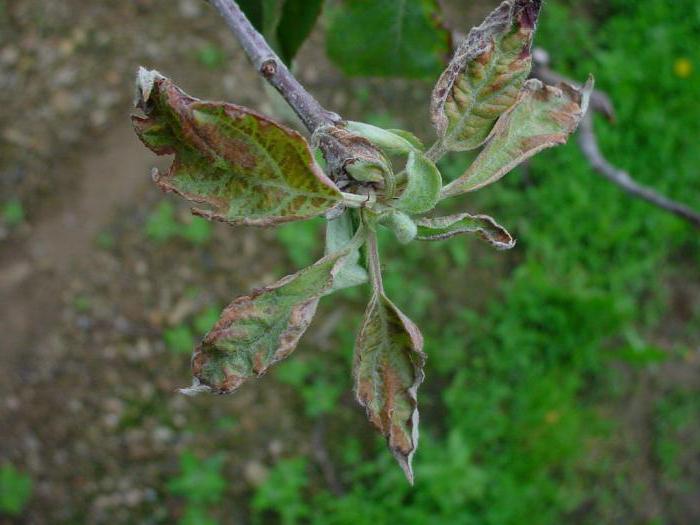

It is necessary to maintain the soil acidity recommended for crops, the composition of microelements. Adequate nutrition helps garden trees to resist pests.
Any protective measures will not completely avoid aphid infestation. Insects fly from neighboring areas, it is impossible to stop them. Folk remedies can be used for prophylactic spraying of apple trees and other horticultural crops.Then single pests will not be able to inflict great damage, total aphid infestation will not occur, and insecticides will not be required.
How to fertilize a tree from aphids?
Improper feeding reduces the resistance of apple trees to pests. It is important to follow the recommended terms and schemes, fertilize in accordance with the age and size of the tree.
Recall the rules for fertilizing apple trees:
- In the snow (March). Complex mineral fertilizers along the edge of the trunk circle, the amount - in accordance with the instructions.
- After thawing - potassium, phosphorus (superphosphate, potassium nitrate, ash). Nitrogen fertilizers are no longer applied, the excess leads to the reproduction of aphids.
- In May, you can add organic matter - manure, bird droppings.
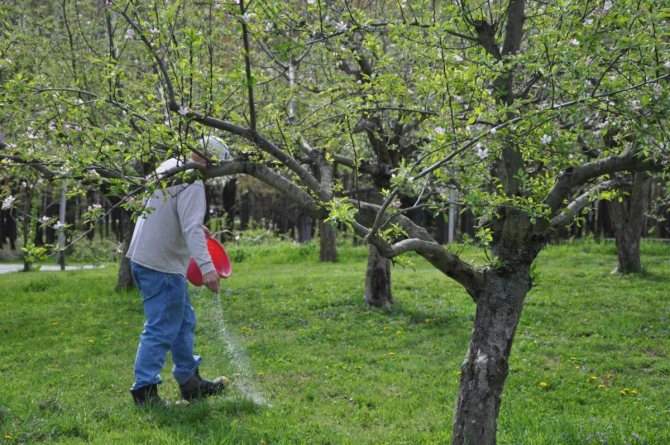

Foliar dressing speeds up the growing season and protects against aphid attacks. Use copper sulfate, urea, you can add Bordeaux liquid to protect against pests. All trees are thoroughly sprayed with the solution.
Nettle infusion protects against aphids of the apple tree. A kilogram of young grass is added to 10 liters of water and kept for about 2 weeks.
To restore the strength of apple trees after an aphid invasion help:
- Microstar is a complex fertilizer in the form of microgranules with a large number of useful elements;
- Herbagreen - complex fertilizer with calcium;
- calcium chloride for foliar dressing.
It is important to help the apple trees regain their lost strength in time and preserve the harvest.
The use of folk remedies and recipes
You can get rid of aphids with the help of folk remedies. However, they act more slowly than chemicals. Consider the most effective folk remedies.
Wood ash
Ash helps to remove aphids in no time. To do this, you can use the following recipes:
- 3 kg of wood ash pour 5 liters of boiling water. Insist for two days, then strain and add 3 tbsp to the resulting infusion. l. liquid soap. Use this product for spraying trees.
- 1.5 kg of ash and 100 g of grated soap are poured into 10 liters of cold water. Leave the mixture for a day. Then it is filtered and used to treat trees affected by aphids.
- Take an equal amount of ash and makhorka. Pour in water and insist for a day. After that, it is filtered and used for its intended purpose.
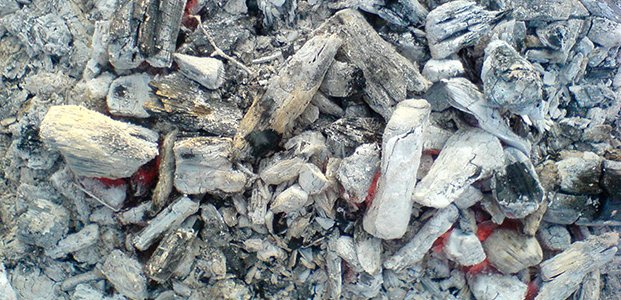

Ash does not harm plants, but strengthens their immunity. It is also sprinkled with soil to increase fertility. If the soil is very acidic, the apple tree may suffer, this reduces its immunity. Therefore, it becomes susceptible to various diseases, quickly dies from pests. After ash treatment, the acidity of the soil decreases.
Soap
Laundry soap is used to combat aphids. It contains nylon acid, which destroys harmful insects. To prepare a soap solution, grate 300 g of 75% soap on a coarse grater. Pour the resulting shavings with 2 liters of warm water, stir well until it is completely dissolved. Pour another 8 liters of water to make a less concentrated product.
Ammonia
An ammonia solution is used to combat aphids. It burns the mucous membranes, leading to paralysis and death of insects. After that, they fall off. If a small number of aphids remain on the tree, re-spraying may be required.
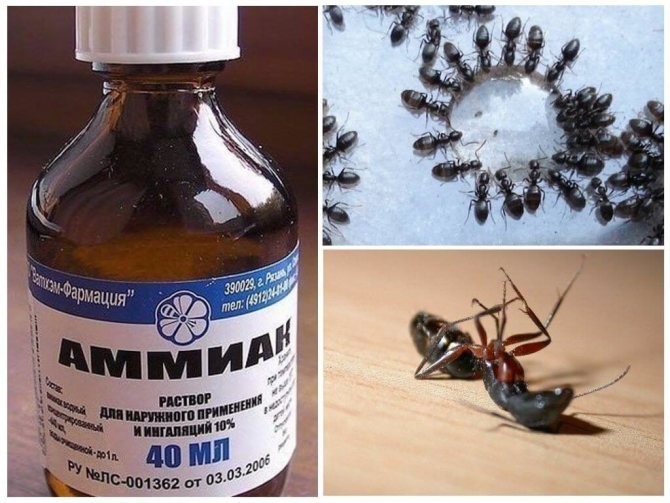

To prepare the solution, it is necessary to add 1 tbsp to 10 liters of water. l. concentrated ammonia and liquid soap.
Garlic
Several effective aphid remedies can be prepared from garlic:
- Infusion of garlic. Divide 10 heads of garlic into cloves, but do not peel them. Pour a liter of water and leave for 3 days. Then drain the liquid and add another 10 liters of water. Use for spraying wood.
- Garlic arrows. They must be laid out under a tree, tied to branches. They have a very pronounced smell, so the aphids fly away.
- Garlic soap solution. It is necessary to grind 400 g of peeled garlic cloves in a meat grinder. Add 3 tbsp. l.liquid soap and pour 10 liters of water. Insist for 3 days. Then strain and process the tree affected by aphids.
See also
Description and characteristics of the Spartak apple variety, planting and growing featuresRead
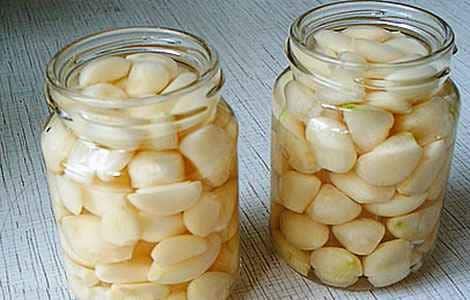

It should be borne in mind that all products made from garlic have a very unpleasant odor. Therefore, when spraying, it is recommended to wear a mask on your face.
Soda
Pour 200 g of baking soda with 10 liters of water and spray the trees. To increase the effect, a small amount of soap can be added to the liquid. So the insects will stick to the leaves, after which they will begin to die under the influence of an alkaline solution.
Also, soda can be used in powder form. To do this, simply sprinkle it with aphids. But this method is effective if there are few insects.
Celandine
There are several ways to use celandine:
- Dusting. It is necessary to collect the dried grass and grind it into powder. After that, treat the affected areas. In addition, such a remedy can be used for prophylaxis during the flowering period - it protects the flowers from harmful insects.
- The use of green celandine. It must be plucked and scattered under the trees. You can also tie celandine to apple tree branches.
- Infusion. In case of mass infestation of aphids, spraying is required. To prepare an infusion of celandine, it is necessary to fill 1/5 of the bucket with chopped grass. After that, pour in 5 boiling water and leave for half an hour. Then strain, add another 5 liters of liquid.
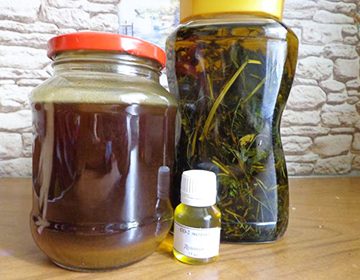

Celandine juice is poisonous to insects. Therefore, as soon as it enters the body of the aphid, paralysis of all systems will occur, so it will die.
Ammonia
Aphids are sensitive to ammonia vapors. Therefore, such a tool can be effectively used to protect the garden from pest infestations. To prepare the solution, dilute 50 ml of ammonia with 10 liters of water. Mix thoroughly and add soap base - 50 g of liquid or grated solid soap. It is necessary for the aphids to stick to the leaves, otherwise it will fly away and not die. It is not recommended to spray the prepared product with a spray bottle, as small drops of ammonia may not reach the tree. In this case, pouring the solution is required from the watering can.
Onion husks
The infusion of onion peels has a very rare odor. Therefore, insects do not tolerate it and leave the sprayed tree. The use of such a tool makes sense if there is only 1 apple tree in the garden. Otherwise, aphids can move from one tree to another. To prepare the infusion, you need to pour 200 g of onion husks with 10 liters of water. Insist 5 days, then strain and spray the trees. Repeat the procedure 2-3 times at intervals of 5 days.
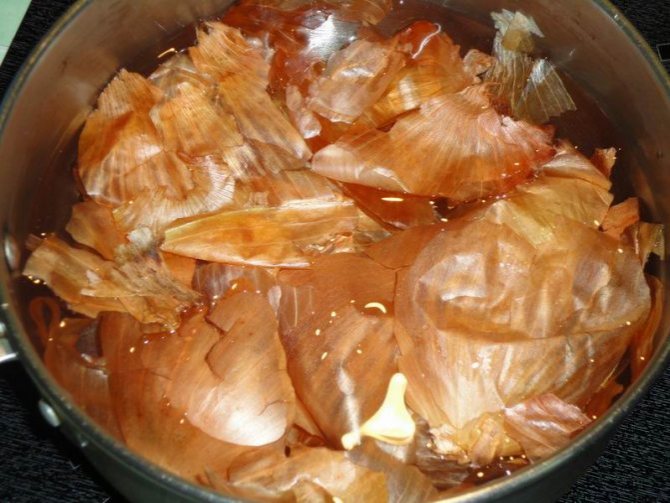

Mustard
After the mustard enters the body of insects, it causes their death. It can be used in various ways:
- Dry mustard. It is necessary to sprinkle the places where aphids accumulate. The substance acts very quickly and aggressively, so the insects will die within a few hours.
- Infusion. Pour 100 g of mustard with 10 liters of water, leave for a day. Then add another 10 liters of water and 30 g of laundry soap.
- Solution. Add 1 tbsp to 10 liters of water. l. mustard and vinegar.
Mustard formulations must be used with caution. They can cause severe burning sensation in eyes.
Tobacco powder
To get rid of aphids, you can grow tobacco on your property, purchase a pack of cigarettes, or use tobacco dust. The easiest is the last option. Tobacco dust is sold in specialty stores, and in order to prepare an aphid repellent, it simply needs to be diluted with water. To do this, pour 50 g of dust with 10 liters of water.
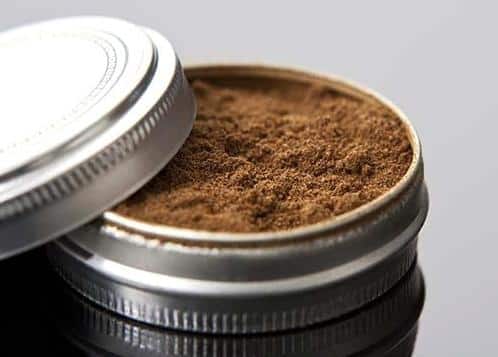

Fumigation can also be carried out. To do this, put a thin layer of straw next to the apple tree, sprinkle with tobacco dust and set it on fire. But you need to watch out for the fire so that it does not spread to the tree.
How to protect seedlings and mature trees from aphids?
It is almost impossible to prevent the appearance of aphids on an apple tree.But, fortunately, it is not so difficult to fight it, and many of the effective remedies for treating the tree are not at all toxic and can be used even at a time when the fruits are already ripening on the apple tree.
Did you know? It is estimated that in the absence of entomophages, aphids would multiply on earth to such an extent that they could cover the entire planet with a dense layer 1 m thick!
Biological methods
Biological methods of aphid control include:
- attracting entomophages to the site - natural enemies of this pest from among insects and birds;
- planting plants, the smell of which scares off aphids;
- the use of modern biological products, which are based on fungi and bacteria that are deadly for the parasite.
In addition to the well-known ladybirds, insects such as gall midges and ground beetles eat aphids with pleasure. They, in turn, are very fond of settling on plants of the umbrella family (carrots, parsley, cilantro, dill, celery, etc.), therefore it is very useful to plant such crops near the apple tree.
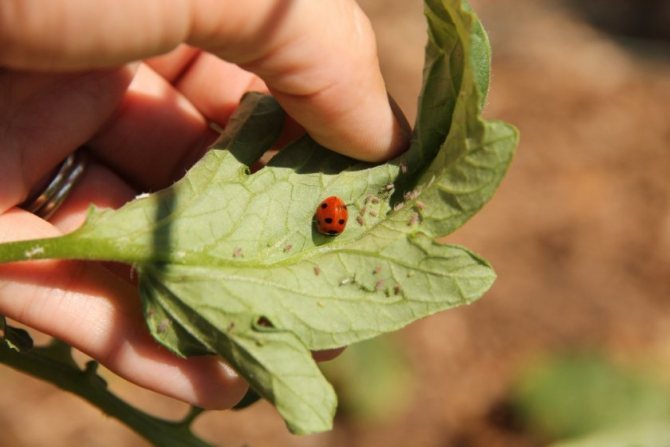

As for ladybirds, today you can even buy them. Stores specializing in agricultural products sell these insects for later settlement in the garden. The cost of a "squad" of 1,500 prefatted adult beetles is approximately US $ 3–8 plus shipping costs.
Natural enemies of aphids in the world of insects are also lacewings, wasps, hoverflies, and some types of flies. You can attract entomophages to the site with the help of various fragrant herbs and even ordinary nettles. Among the birds that hunt aphids, the first to be named are tits, robins, linnet and sparrows.
But for starlings, such an insect is too small prey, so you should not rush to install birdhouses on the site in order to fight this pest. Aphids do not like the smell of some garden and meadow plants. In particular, marigolds, calendula, tansy, lavender, chamomile, hemp, and from vegetables - tomatoes, onions and garlic can scare away the insect. But nasturtium, mallow, begonia, as well as viburnum and linden, on the contrary, attract winged pests to the site.
See also
How to deal with a flower beetle on an apple tree and how to treat trees
Among the bioinsecticides that can destroy aphids and other insects parasitizing on an apple tree are:
- Fitoverm;
- "Entobacterin";
- Akarin;
- "Arrow";
- "30-plus";
- Tanrek;
- Biotlin;
- "Confidor extra".
Chemicals
Chemical insecticides, on the other hand, give a quick and reliable effect in pest control, but they can only be used in early spring or late autumn, after harvest. Therefore, usually this kind of means is used, without waiting for the destruction of the tree, for preventive purposes.
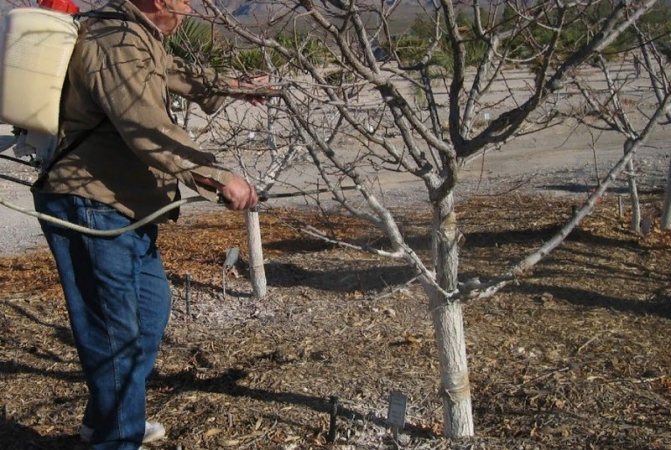

The modern chemical industry offers a wide variety of systemic insecticides, many of which are effective in controlling aphids.
Some of these drugs are listed below, however, when choosing a suitable remedy for yourself, you need to remember that you should not use it constantly from year to year: on the one hand, it brings great harm to the environment, on the other, it causes resistance in the pest, after which over time, the insecticide ceases to work.
Important! Regardless of what kind of preparation is used for processing an apple tree, you need to calculate its amount, based on the fact that an adult tree will need about 5 liters of working solution, and for a seedling, depending on its age, from 2 to 3 liters.
"Nitrofen"
To control pests wintering in the bark, our close ancestors used "Nitrofen". This agent is able to destroy not only aphids and many other insects, but also ticks, spores of pathogenic fungi and even some weeds, thus it has an insecticidal, acaricidal, fungicidal and herbicidal effect at the same time.
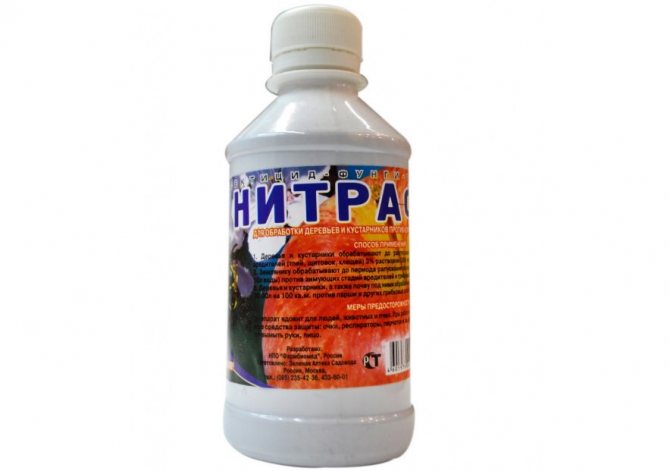

However, "Nitrofen" is a very toxic drug, so much so that for some time its use was even officially banned. "Nitrofen" should be diluted in a proportion of 300 g per 10 liters of water and spray the tree "on a green cone" (at the time of the swelling of the buds).
"Oleocobrite" 4%
As an analogue of "Nitrofen", along with such well-known insecticides as copper and iron vitriol, the drug "Oleocobrite" should be called.
Important! Complete decomposition period
«
Nitrofen
»
in the soil is approximately 4 years!
Its active ingredients - copper naphthenate and petroleum oil - are capable of destroying many pests even at the egg stage, which is why it is advisable to treat with Oleocubrite, as well as with Nitrofen, at the very beginning of spring, while the buds have not yet blossomed, and most pests continue to stay in the bark of a tree in a sleepy state.
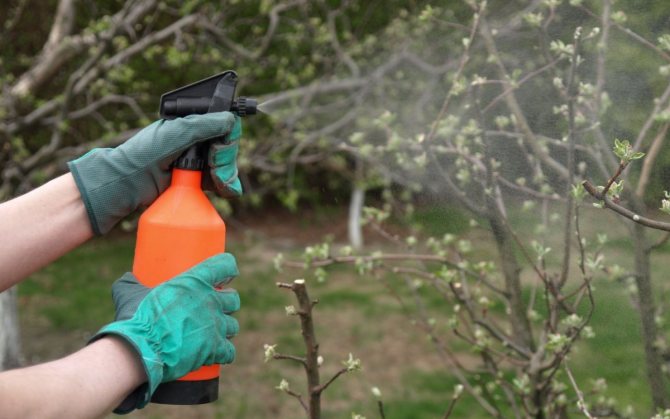

The same remedy is the prevention of certain fungal infections, in particular, scab, which very often affects apple orchards. "Oleocobrite" is a green liquid, which must be diluted with water in the proportion of 400 g of the preparation per 10 liters of water before use.
The drug is very toxic, therefore, its use in private households cannot be considered a successful way to protect the garden, in any case, more than one treatment during the season should definitely not be carried out.
"Kinmix"
"Kinmiks" is a Hungarian insecticide of contact-intestinal action, paralyzing and killing insects, including at the larval stage, but powerless against their eggs. The drug has a delayed effect - after processing, its insecticidal qualities remain for 3 weeks.
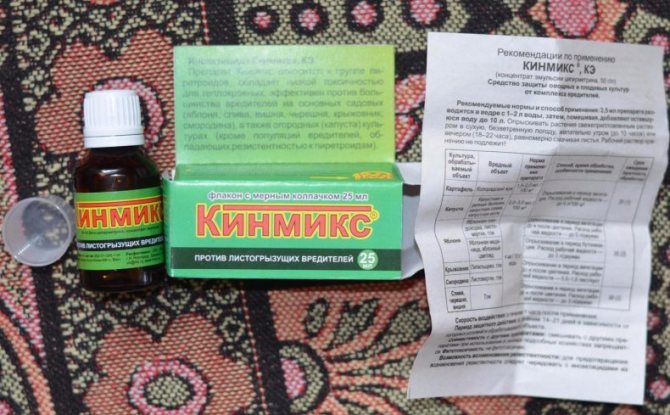

To fight against aphids on an apple tree, "Kinmix" is used twice: the first treatment is carried out after bud break, and the second one after 2 weeks.
If the spring is rainy or if an aphid infestation has hit the garden in the summer, a third spraying is allowed, however, apples from the tree can then be removed and eaten no earlier than 3 weeks later.
The working solution is prepared at the rate of 1 ampoule (2.5 ml) of the drug per 10 liters of water, and it must be used no later than within 3 hours after preparation. It is also important to remember that during processing, special attention should be paid to the underside of the leaves, because this is where the aphid accumulation is concentrated.
Important! Unlike
«
Nitrofen
»
and
«
Oleocubrite
»
,
«
Kinmix
»
practically safe for humans and other warm-blooded animals, however, it is deadly for bees, therefore, it is necessary to warn about the processing of neighboring beekeepers.
"Inta-vir", "Karate"
Inta-vir is a drug created on the basis of the same active ingredient as Kinmix. Once in the insect's body, cypermethrin (this is the name of this active substance), causes paralysis of the nervous system and other organs of the pest, which subsequently leads to its death.
Inta-Vir does not work as long as Kinmix (no more than 10-15 days). The product is sold in tablets, each of which is designed for 10 liters of water. The prepared solution should be used immediately.
It is possible to process apple trees from aphids with Inta-vir:
- before flowering;
- immediately after flowering;
- in the middle of the season, no later than 3 weeks before harvesting;
- in the fall, after the harvest is harvested.
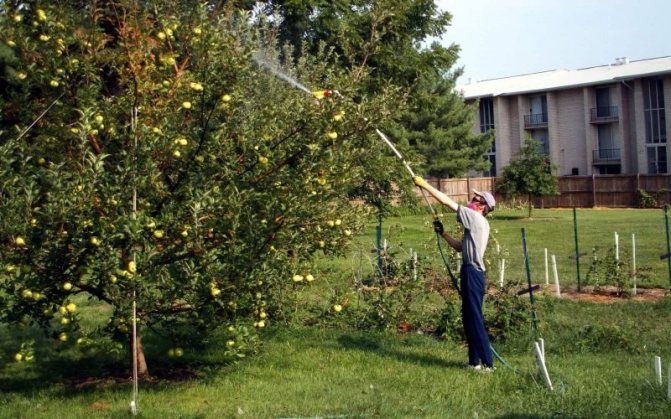

Analogues of Inta-Vira are drugs such as Arrivo, Iskra, Alatar and Sharpey. But the insecticide "Karate" is made on the basis of another active substance, namely, lambda-cyhalothrin.
It is also used for prophylactic treatments of the apple tree (to prepare a solution in 10 liters of water, 5 ml of the preparation should be diluted), however, “Karate” is less effective against the apple aphid. The tool first of all allows you to get rid of ticks, leafworms and moths, but aphids with the help of this drug are destroyed on peas, strawberries, raspberries, currants and cherries.
Important! «Karate
»
it is very dangerous for bees, as well as fish, and therefore its remains are strictly prohibited to be discharged into water bodies. In addition, this agent is toxic and for warm-blooded, in particular, herbivores, should not be grazed on the plots immediately after treatment.
Folk remedies
You can get rid of aphids on an apple tree with the help of folk remedies. Most of them, like biological products, are safe for wood and ecology, and if used at the first signs of damage, they can be no less effective than pesticides. The only important caveat is that such drugs should be changed constantly, since the pest gets used to them much faster.
Ammonia
Ammonia (ammonia) is good because it contains nitrogen, which means that it is also a good fertilizer for wood. Before using ammonia, you should remember that you cannot fertilize trees with nitrogen in autumn, since such feeding stimulates the active growth of young shoots, which freeze out in winter, which is very harmful for the tree.
Video: how to get rid of aphids on an apple tree using ammonia
It is noteworthy that ammonia vapors are so aggressive that they instantly paralyze the respiratory system of not only aphids, but also ants "grazing" it, thus destroying both the pest and its main carrier.
To prepare the working solution in a bucket of water, mix 1 tbsp. l. ammonia and 1 tbsp. l. liquid soap (the latter is necessary to increase the contact of the poison with the leaf plate and branches).
Recommended reading
What to plant apple trees under a tree for beauty and maximum benefit And yet, it should be recognized that the effectiveness of ammonia to combat aphids on fruit trees is much less than when treating garden crops with a similar agent.
The fact is that the spraying method itself in the case of ammonia does not work well, so vegetables are usually simply watered with a solution of ammonia from a watering can.
The effect of the drug is also very short-lived.: as soon as the smell disappears, the insecticidal effect disappears.
But with the help of ammonia, you can purposefully fight ants.
In this case, 100 ml of ammonia (full bottle) is diluted in a bucket of warm water and, after digging a little into the anthill, quickly pour into it all the prepared mixture from a watering can with a narrow spout.
After a few days, the procedure is repeated. It is believed that even those individuals who survive will choose to leave their home and build a new home for themselves. The gardener can only hope that the ants will find a suitable place outside of his plot.
Video: fighting aphids and ants on trees
Tobacco
A drop of nicotine, as you know, kills a horse, and to destroy aphids on an apple tree, it is enough to prepare an infusion of tobacco or makhorka. As raw materials, you can use shredded cigarettes without a filter and even cigarette butts. The period of infusion of tobacco infusion is 24 hours.
Did you know? Scientists have found that when unfavorable conditions arise (overpopulation, lack of food, an abundance of natural enemies, etc.), the aphid begins to emit special aromatic substances, which, at the genetic level, somehow lead to the birth of a generation of winged individuals capable of moving to new territories.
Based on a bucket of water, dry leaves or stalks of tobacco should be taken up to 1 kg, tobacco or cigarettes - 2 packs. You always need to pour boiling water over the tobacco in order to speed up the process of saturating the water with the active substances of the plant. The resulting infusion should be diluted with water in a 1: 1 ratio before use.
Soap
The soap film covering the leaf is a proven and very effective way to control aphids in the garden and in the vegetable garden. To prepare a working solution, it is better to use liquid soap versions, since, unlike solid ones, it is much easier to dissolve them in water.The ratio of soap and water is about 10 ml / 10 l, the frequency of treatments is 2-3, depending on the degree of damage to the tree.
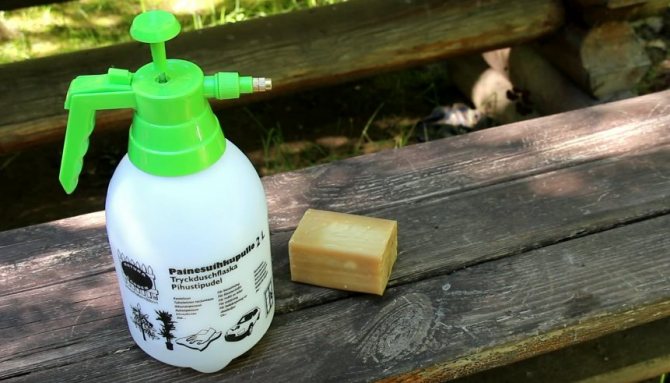

Spice
As mentioned, many plants with a strong spicy scent will repel aphids. On this feature of the insect, the preparation for combating this pest of decoctions and infusions from various spices, spices, meadow herbs and other plant products is based.
Here are just a few examples of this kind of drugs:
| Plant | Preparation method |
| Hot chili |
|
| Garlic |
|
| Cloves, anise, cinnamon |
|
| Onion peel |
|
| Horseradish |
|
| Celandine |
|
| Pine shoots |
|
| Dandelion, chamomile, tansy or yarrow |
|
| Potato or tomato tops (stepsons can be used) |
|
Soda
Baking soda, like ammonia, is best used in combination with soap to fight aphids. The classic recipe for soda insecticide involves adding 10 tbsp of soap to 10 liters of soap solution. l. food or 5 tbsp. l. soda ash. The soap solution itself is prepared according to the recipe described earlier.
Important! An overabundance of soda on leaves and ovaries can inhibit tree development and negatively affect yield indicators.
Preventive measures
If some agrotechnical secrets are observed, the likelihood of mass spread of aphids on the site can be significantly reduced. The first and most important condition for preventing aphids from entering the apple tree is the fight against ants. Unfortunately, it is much more difficult to expel these insects from the garden than many other pests, but without this, saving trees from aphids turns into a fight against windmills.
There are many special preparations against ants, but some of these agents (for example, kerosene) are detrimental to the soil and the natural microflora present in it, while others do not show high efficiency. However, the removal of ants from the site is not the only measure to prevent the appearance of aphids on the apple tree.
Video: fighting ants and aphids on trees
Other equally important events include the following:
- Regular struggle with garden shoots and tops - thin and growing almost vertically, which appear after pruning and do not form fruit. It is these delicate branches that are the site of mass wintering of many species of aphids.
- Planting fragrant plants under an apple tree that attract ladybirds, and the obligatory leaving of the remains of these plants for the winter, so that the natural enemies of aphids have a place to wait out the cold.
- Monitoring the condition of the tree bark and its timely treatment.
- Thorough weeding in the area of the trunk circle.
- Competent and dosed feeding of the tree in order to maintain the balance of all the nutrients it needs.
- Periodic use of fermented grass infusion for watering the apple tree (for this you need to fill 1/3 of a bucket with finely chopped meadow grass, add water to it to the brim and leave it in a warm place for 1.5–2 weeks). It was also noticed that the resistance of the apple tree to the attacks of aphids can be increased by the wood ash introduced under the tree.
Did you know? To extract honeydew, which is a favorite delicacy of ants and the main reason for their tender attitude towards aphids, cunning insects tickle the belly of aphids with their antennae, for which they receive a portion of nectar as a reward, like a glass of sweet soda from an automatic machine.
Aphids on fruit trees are an uninvited guest, but frequent. The usual spring preventive treatments with insecticides do not always help to prevent the appearance of this pest on the tree. Therefore, to effectively combat aphids, the gardener needs to learn to use any means, including such "military tricks" as attracting natural enemies of aphids, of which, fortunately, there are quite a few, as well as the destruction of its allies and defenders - ants.
Means of struggle
Usually aphids appear on those apple trees that grow on soil. from deficiency of phosphorus, magnesium and boron, but with an excess of readily available "organic" nitrogen. Remember that fertilizing the soil is a very important part of gardening and you can overdo it when trying to "improve" the soil.
Therefore, it happened that it was enough for the gardener to feed the apple trees a decoction of superphosphate with the addition of borax or apply the missing batteries on the sheet, while trim off the tips of apple twigs with a bunch of aphids, and the problem disappeared for the whole summer.
But sometimes there were especially difficult years, when literally "outbreaks" of the number of aphids were observed. Here it was necessary to look for other culprits of this outrage, namely the ants. After all the main "breeder" of aphids - ants, they feed on their sweet juice and increase their "livestock" to obtain such nutrition.
Therefore, the main stage in the fight against aphids will be steps towards the simultaneous extermination of both aphids and ants. Not bad trapping stripes will help on the stem of the apple trees.
Often it is old agrofibre with a pungent-smelling substance, such as carbolic solution or oil infused with the fruits of anise.
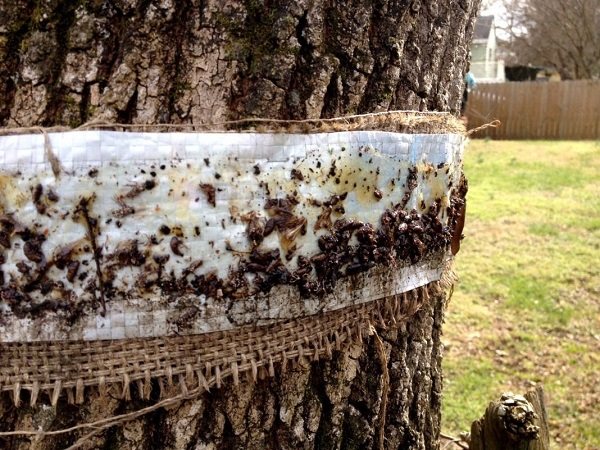

Ant hunting belts.
If a apple trees are young or dwarfs, then their trunks are abundant rub with green onions or garlic arrows, and such trees become unpopular with ants.
But if all non-toxic methods do not work, then one thing remains - apply natural poisons... Good help:
- Broth of tobacco;
- Infusion of bitter pepper;
- Wormwood Napar.
Attention! Using natural poisons, it is necessary to protect the respiratory system and eyes, because they are dangerous for humans too!
If synthetic poisons are needed, then poisons containing the least dangerous substances for nature and apple trees:
- Carbosulfan;
- Tiacloprid;
- Thiamethoxam.
Watch the video on how to deal with aphids on an apple tree in summer:
Other means
In the process of killing aphids, other insects can help. To lure them to the site, you must follow some recommendations.
Such insects feed on aphids:
- Ladybug larvae. It is difficult to attract them, it is easier to buy them in flower shops. After that, release them on the apple tree.
- Ground beetle. To attract her, it is necessary to plant nightshade crops in the garden.
- Hoverflies. It is necessary to plant daisies under the tree, the pollen of which these insects feed on.And their larvae eat adult aphids and their larvae.
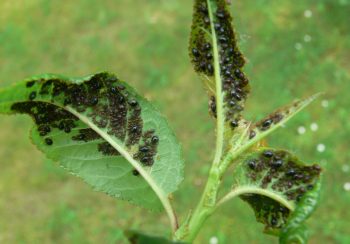

Birds can also help control pests. To attract them, it is necessary to place birdhouses, feeders, drinkers in the garden.
Green and red-gall aphids
Ants on an apple tree how to fight
The green apple aphid is recognized as one of the most harmful parasites for this tree. It is an insect, the length of which is not more than 3 mm, with a green or yellowish color. The female lays eggs in the buds of the plant, she is capable of producing about 100 pieces of black eggs, each of which is no more than half a millimeter in size.
Its larvae are born at the very beginning of spring and very soon crawl into the bud that has already blossomed. With their thin proboscis, they drink all the juices from it. Also, green aphids eat the shoots and leaves of the plant. Aphids are attacked by a number of insects and birds, but this is not enough to completely destroy the pest.
An equally dangerous insect that causes very serious damage to apple orchards is the red-gall aphid. It can attack various varieties of these fruit trees. At the same time, it damages the fruit to such an extent, leaving behind spots of red color that there is no need to talk about any marketable form of apples.
This aphid looks like a wide oval, almost a circle. The females are only 2 mm long. The color can be either green or gray.
Males can be even smaller in size - about 1.5 mm. They have black stripes across the abdomen.
Male aphids
The eggs laid by the red-gall aphid are initially yellow in color, but after a short period of time, about 3 days, change color to a paler shade of yellow.
She begins active actions when the foliage blooms. The born larvae settle on the leaves, usually on the lower side of them. From the edges, the leaves begin to thicken, become coarser, and then curl. Hillocks appear red or pink. Leaves that have been heavily influenced by the pest eventually dry up and die.
Before flowering occurs, females of this species are more fertile, producing up to 70 larvae, and later only up to 15 larvae. Approximately 4 generations occur during one season. In June, in the colonies of the red-gall aphid, males that can fly and females that do not have wings appear.
Harm
At first, aphids can be quite problematic to find on an apple tree.since initially he settles closer to the top of the tree. Then, after eating most of the upper leaves, it begins to move lower and lower. There it can already be easily found, it will be enough to turn over any affected leaf.
Important! In the process of vital activity, aphids leave on the leaves the products of their processing - honeydew, which subsequently ants, flies, wasps and bees enjoy with pleasure. Therefore, if the above insects are constantly present on the apple tree, then this is one of the signs of the presence of aphids.
Aphids are a migratory insect that can travel through the air, therefore, even on the treated area, it may appear. From this it follows that checking garden trees for the presence of these pests should be carried out at regular intervals.
It should also be remembered that in addition to eating leaves, aphids are a carrier of numerous diseases, including viral ones. Therefore, it is imperative to exterminate it on your site.
Pest signs
Understand which pest "Attacked" your garden is not so difficult.
- Red swellings appear on the leaves;
- The leaves on the apple tree curl, turn black and dry up;
- Shoots stop growing;
- The tops of the apple tree are curved;
- A sticky pad appears on them, onto which ants crawl.
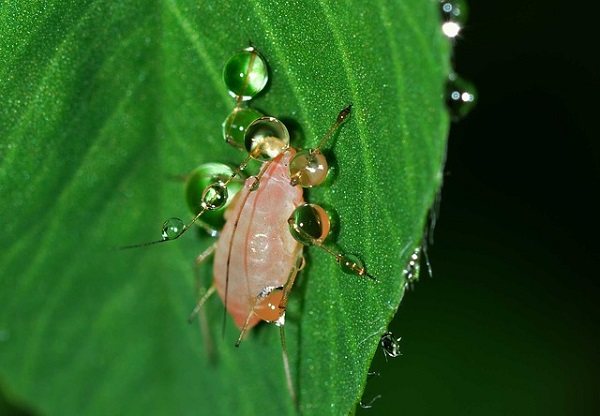

Fall formed during the life of aphids.
Aphids continue to move through the tree.It begins to parasitize at the apical part, so you will not be able to detect it immediately. After it, emaciated and weak shoots and leaves remain. Finding aphids is quite simple: you need to turn the leaf over, and a colony of small green insects will appear in front of you. The presence of ants on an apple tree can also alert and make you carefully examine it.
You should know it! Aphids do not just parasitize on an apple tree, they also carry viral infections, which can cause serious damage to cultivated plants. In addition, it causes serious damage to young cultures.
So, we found out that in your garden aphids on an apple tree - what to do? Fighting aphids is not easy: the breeding process is fast and constant. For active destruction of insects, you can use both folk, traditional preparations and modern chemical agents. In addition, there are natural helpers.
Mechanical methods of struggle
You can also remove aphids by mechanical means. However, such methods are less effective. The point is that insects can return. Mechanical methods include:
- Remove aphids with your hands. This is a rather problematic activity, since the insects are very small. And when you touch them, they are easily crushed. Therefore, in order not to get your hands dirty, it is recommended to wear gloves.
- Wash off aphids with water pressure. However, in this case, it does not die, so after a while it can return to the tree.
- Cut off affected branches and burn. This method is effective only if the insects have just appeared and have not had time to populate the entire tree. And if you remove too many branches, the apple tree may suffer.
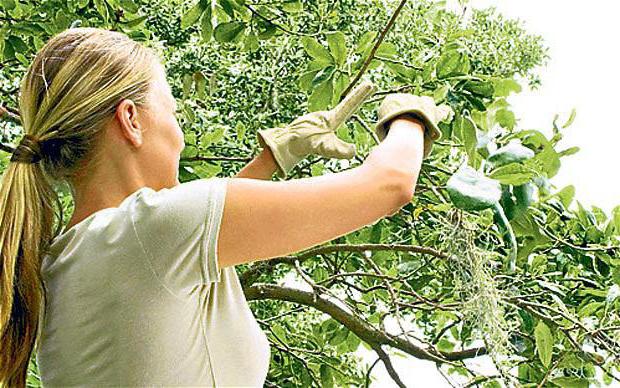

Unfortunately, there are no baits for these pests, as they love to feast on only green leaves. Therefore, to combat it, you have to use one of the above means.
Prevention measures
Many gardeners recommend fighting aphids at the stage of its appearance... After all, it is much easier to defeat a small focus of infection than to subsequently get rid of pests on the entire tree.
Preventive measures include regular watering of trees, especially during the dry season, the introduction of necessary fertilizers and fertilizing into the soil, mulching, and sprinkling of the crown.
Before the onset of cold weather, all trees should be properly prepared for winter.... Namely, to process their bark, thereby destroying the larvae of aphids. It is also necessary to cut or break off diseased branches and remove the affected bark from the trunk.
Prevention of aphids on apple trees
To avoid the appearance of aphids in the garden, a number of preventive measures must be followed. Often, she is brought into the garden along with the seedlings. Therefore, they must be carefully inspected before purchasing. It is recommended to plant only healthy seedlings in the ground.
For preventive purposes, it is necessary to attract birds to the territory. They will prevent the emergence of not only aphids, but also other harmful insects.
To prevent the occurrence of any pests and diseases, it is necessary to spray the garden in early spring. Aphid eggs are resistant to low temperatures, so they do not die in winter frosts. And until the first leaves appear, they are in hibernation. Therefore, at this moment you can easily destroy them without harm to the plant. Thus, aphids are an insect that adversely affects the condition of the tree. To avoid its death and decrease in yield, it is necessary to prevent the invasion of aphids and destroy it in time.
Mechanical protection methods
Of physical traps and baits, they use trapping belts... For this, a masking tape is taken and wrapped around the trunk (about half a meter from the ground). A sticky layer of glue from rodents and insects is applied to it along the circumference of the trunk.
Disadvantage: on hot days the glue runs off.
You can wrap it around the trunk below the masking tape foam layer and its upper part also grease with glue... This method is more reliable.Neither ants nor aphids can climb the trunk.
There are some agrotechnical methodshow to save an apple tree from ants and aphids, but they ineffective:
- Picking up weeds and digging the garden;
- Removing aphids from foliage manually;
- Rinsing off with a powerful jet of water.
Preventive measures can also be used. Such as, for example ant control, attraction to the site natural enemies aphids.
Attention! Do not overfeed the tree with nitrogen fertilizers, because it is the young greenery that attracts aphids.

